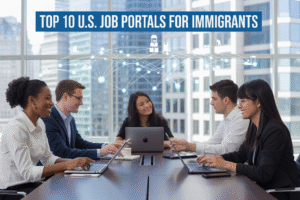Finding your first job in America can feel overwhelming when you’re navigating a new country, unfamiliar systems, and different workplace cultures. This comprehensive guide on how to find a job as an immigrant in USA is designed for recent immigrants, visa holders, and anyone starting fresh in the American job market who wants proven strategies that actually work.
You’ll discover the job search strategies for new immigrants that successful job seekers use, from understanding what documents you need before you even start applying to mastering the American resume format that catches hiring managers’ attention. We’ll also uncover the hidden job market USA where most opportunities never get posted online, and show you exactly how to tap into this goldmine of possibilities.
By the end of this guide, you’ll know how to leverage both digital platforms and government resources for immigrant job seekers to land interviews and secure job offers faster than you thought possible.
Essential Documents and Credentials You Need Before Starting Your Job Search

Work Authorization Documents and Visa Requirements
Your ability to work legally in the United States depends entirely on having the right documentation. If you’re on an H-1B, L-1, or O-1 visa, your work authorization is tied to your specific employer. Green card holders and naturalized citizens have unrestricted work rights, while those on F-1 student visas can work through Optional Practical Training (OPT) or Curricular Practical Training (CPT).
Keep multiple copies of your work authorization documents, including your I-94 arrival record, visa stamp, and Employment Authorization Document (EAD) if applicable. Many employers will ask for these during the hiring process, and you’ll need them for Form I-9 verification on your first day.
Check your visa expiration dates regularly. If your status is about to expire, start the renewal process early. Some employers hesitate to hire workers whose authorization expires soon, so having a clear timeline helps during negotiations.
Professional Credential Evaluation and Translation Services
Your foreign degrees and certifications carry significant value, but employers need to understand how they translate to U.S. standards. Professional credential evaluation services like World Education Services (WES), Educational Credential Evaluators (ECE), or Josef Silny & Associates can provide official assessments of your education.
The evaluation process typically takes 2-4 weeks and costs between $100-300. You’ll receive a detailed report showing U.S. equivalents of your degrees, which many employers and licensing boards require. For regulated professions like healthcare, engineering, or teaching, these evaluations are mandatory.
If your documents are in another language, you’ll need certified translations from accredited translation services. Keep both original and translated versions of all certificates, transcripts, and professional licenses. Some states have specific requirements for professional licensing, so research your field’s requirements in your target location.
Building Your U.S. Credit History from Day One
Starting your credit history immediately gives you a significant advantage in your job search and life in America. Many employers, especially in finance, government, or positions requiring security clearances, check credit reports as part of their background screening process.
Apply for a secured credit card within your first month. Bank of America, Capital One, and Discover offer cards specifically designed for new immigrants. You’ll deposit money as collateral, typically $200-500, which becomes your credit limit. Use the card for small purchases and pay the full balance monthly.
Add yourself as an authorized user on a trusted friend or family member’s credit card if possible. This can help establish credit history faster. Also, consider credit-builder loans from local credit unions, which are designed specifically for people building credit.
Set up automatic payments for all your bills – rent, utilities, phone, and insurance. Payment history makes up 35% of your credit score, so consistent on-time payments are crucial. Monitor your credit score monthly through free services like Credit Karma or your bank’s mobile app.
Social Security Number Application Process
Getting your Social Security Number (SSN) should be your first priority after arriving in the U.S. Most employers require an SSN for payroll processing, and you’ll need it for credit applications, bank accounts, and background checks.
Visit your local Social Security Administration office with your passport, visa, and I-94 record. If you’re on a work visa, bring your employment authorization documents. The process is free and typically takes 10-15 business days to receive your card by mail.
You can apply for an SSN before you have a job offer if you have work authorization. Don’t wait until after you’re hired, as this creates delays in your start date. If you need to start working before your SSN card arrives, your employer can use a receipt letter from the Social Security office as temporary documentation.
Some employers might try to use an Individual Taxpayer Identification Number (ITIN) instead of an SSN, but this limits your employment opportunities and complicates tax filing. Always pursue the SSN if you’re eligible for work authorization.
Master the American Resume Format That Gets You Interviews

Key Differences Between U.S. Resumes and International Formats
Your international resume might be impressive, but it could be sabotaging your American job search. The American resume format follows distinct rules that differ dramatically from formats used worldwide.
First, never include a photo, personal details like marital status, or date of birth. These elements, common in European CVs, can actually hurt your chances due to anti-discrimination laws. American employers want to focus solely on your qualifications.
Length matters too. Keep your resume to one or two pages maximum, regardless of your experience level. While some countries expect detailed, multi-page CVs, American hiring managers prefer concise, results-focused documents that quickly highlight your value.
The structure should start with a professional summary, followed by relevant work experience in reverse chronological order. Skip the lengthy personal statements common in other formats. Instead, lead with 2-3 powerful sentences that showcase your biggest accomplishments and career goals.
Education placement varies by experience level. New graduates should list education near the top, while experienced professionals should place it after work experience. Don’t include grades unless specifically requested.
ATS-friendly Formatting Techniques That Beat Applicant Tracking Systems
Over 90% of large companies use Applicant Tracking Systems (ATS) to screen resumes before human eyes see them. Your perfectly crafted resume means nothing if it can’t pass this digital gatekeeper.
Choose simple, clean fonts like Arial, Calibri, or Times New Roman in 10-12 point size. Avoid fancy formatting, graphics, tables, or columns that confuse ATS software. Stick to standard section headings like “Work Experience,” “Education,” and “Skills” rather than creative alternatives.
Use standard bullet points instead of special characters or symbols. Save your resume as both a Word document and PDF, but submit the format requested in the job posting. Many ATS systems struggle with PDFs, so Word documents often parse better.
Mirror the job posting’s language and keywords naturally throughout your resume. If the posting mentions “project management,” don’t substitute it with “project coordination.” The ATS looks for exact matches, and this simple technique can dramatically improve your visibility.
Create separate resume versions for different job types, each optimized with relevant keywords. Don’t stuff keywords unnaturally, but weave them into your experience descriptions where they genuinely apply.
Quantifying Achievements Using American Business Metrics
American employers love numbers that prove your impact. Transform vague descriptions into powerful, quantified achievements that speak the language of American business.
Replace “managed a team” with “supervised 12-person cross-functional team, reducing project delivery time by 25%.” Instead of “increased sales,” write “boosted quarterly revenue by $2.3M through strategic client partnerships.”
Use percentages, dollar amounts, timeframes, and scope indicators wherever possible. If you don’t have exact numbers, make reasonable estimates based on your knowledge. “Approximately” or “over” can help when precision isn’t possible.
Focus on results that matter to American businesses: cost savings, revenue growth, efficiency improvements, customer satisfaction increases, or market expansion. These metrics resonate with hiring managers who need to justify their hiring decisions to leadership.
Convert international currencies and metrics to American equivalents. List budget figures in USD and use familiar measurements. This small effort shows cultural awareness and makes your achievements more relatable to American employers.
Time-based achievements work especially well: “Reduced customer response time from 48 hours to 2 hours” or “Completed 6-month project in 4 months while staying 15% under budget.” These concrete examples demonstrate your ability to deliver measurable results in the fast-paced American business environment.
Decode the Hidden Job Market Where 80% of Opportunities Exist

Leveraging Professional Networking Events and Industry Meetups
Professional networking events and industry meetups are goldmines for immigrant job seekers who want to tap into the hidden job market USA opportunities. These gatherings happen regularly in most major cities and provide direct access to hiring managers, industry professionals, and decision-makers who often fill positions before they’re ever posted online.
Start by checking platforms like Meetup.com, Eventbrite, and professional association websites in your field. Many industries host monthly or quarterly events specifically designed for networking. Tech workers can find meetups at local co-working spaces, while healthcare professionals might connect at medical society gatherings. Financial professionals often network at chamber of commerce events or industry-specific conferences.
Preparation makes all the difference at these events. Create a 30-second elevator pitch that explains who you are, your background, and what type of opportunities you’re seeking. Practice this until it feels natural. Bring business cards or have a digital business card ready on your phone. Many successful connections happen when you can easily share your contact information.
The key to successful networking as a new immigrant is to focus on building genuine relationships rather than immediately asking for job leads. Show interest in others’ work, ask thoughtful questions about their industry, and offer to help with their challenges if you can. This approach often leads to meaningful connections that result in job referrals weeks or months later.
Building Strategic Relationships on LinkedIn for Job Referrals
LinkedIn serves as the digital hub for professional networking and job search strategies for new immigrants. The platform’s power lies not just in applying to posted jobs, but in building relationships that lead to internal referrals – which account for roughly 30-50% of all hires in many companies.
Start by optimizing your LinkedIn profile with keywords relevant to your target positions. Connect with professionals in your industry, including alumni from your university, people who work at companies you’re interested in, and others in your field. When sending connection requests, always include a personalized message explaining why you want to connect.
Engage actively with content in your industry by commenting thoughtfully on posts, sharing relevant articles, and creating your own content about your professional experiences or insights. This visibility helps establish your expertise and keeps you on the radar of your network.
The most effective LinkedIn strategy involves reaching out to employees at companies where you want to work. Send friendly messages asking about their experience at the company or insights about the industry. Many professionals are happy to share their perspectives, especially with fellow immigrants who they can relate to. These conversations often reveal upcoming openings or lead to introductions to hiring managers.
Accessing the Unadvertised Job Market Through Informational Interviews
Informational interviews represent one of the most underutilized immigrant job hunting tips, yet they provide direct access to the 70-80% of jobs that never get publicly advertised. These conversations involve reaching out to professionals in your target field to learn about their career path, industry trends, and company culture.
The beauty of informational interviews is that they’re low-pressure for both parties. You’re not asking for a job directly, which makes people more willing to meet with you. Start by identifying professionals whose career paths interest you or who work at companies you’d like to join. Reach out through LinkedIn, email, or mutual connections, requesting 15-20 minutes of their time to learn about their experience.
Prepare thoughtful questions about their role, how they got started in the industry, what skills are most valuable, and what trends they see affecting their field. Ask about their career journey and any advice they have for someone new to the American job market. Often, these conversations naturally lead to discussions about opportunities within their organization or referrals to other professionals.
Many informational interviews result in job opportunities because you’re building relationships with people who understand your qualifications and can advocate for you when positions open up. Keep in touch with these contacts by sending occasional updates about your job search progress or sharing relevant industry articles.
Finding Mentors Within Your Target Industry
Securing a mentor in your target industry can dramatically accelerate your understanding of finding work as new immigrant America and provide ongoing guidance throughout your career. Mentors offer insider knowledge about industry expectations, company cultures, and career advancement strategies that you might not discover on your own.
Look for potential mentors through professional associations, alumni networks, immigrant professional groups, and LinkedIn connections. Many successful professionals remember their own early career challenges and are willing to help others, especially immigrants who face similar obstacles they may have experienced.
When approaching potential mentors, be specific about what type of guidance you’re seeking. Rather than asking someone to be your mentor directly, start by requesting advice on specific challenges you’re facing. This natural relationship-building approach often develops into ongoing mentorship organically.
Professional immigrant organizations in major cities often have formal mentorship programs that pair experienced professionals with newcomers. These programs provide structured support and are particularly valuable because mentors understand the unique challenges immigrants face in the American job market.
Successful mentoring relationships require commitment from both sides. Be respectful of your mentor’s time, come prepared with specific questions, and follow up on the advice they give you. Share your progress and successes, as mentors often take pride in seeing their mentees succeed and may become even more invested in helping you advance your career.
Navigate Job Search Platforms Like a Pro

Optimizing your profiles on Indeed, LinkedIn, and Glassdoor
Creating standout profiles on major job search platforms for immigrants requires strategic thinking and attention to detail. Start with LinkedIn by uploading a professional headshot and crafting a compelling headline that goes beyond just your job title. Include keywords from your target industry and mention your immigrant status positively, such as “Bilingual Marketing Professional | New to the US Market with Global Perspective.”
Your LinkedIn summary should tell your story in 2-3 paragraphs, highlighting transferable skills and your unique value proposition. Don’t hide your international background – frame it as an asset. Include specific achievements with numbers and metrics wherever possible.
On Indeed, your profile acts as a mini-resume. Upload a complete profile with work history, even if some experience was gained outside the US. Use the platform’s assessment tests to validate your skills and increase profile visibility. These badges appear prominently and help overcome initial credibility concerns employers might have.
Glassdoor serves dual purposes – job searching and company research. Complete your profile thoroughly and contribute company reviews if you have relevant experience. This builds credibility and shows you’re an engaged professional. Use Glassdoor’s salary insights to understand market rates and negotiate confidently.
Across all platforms, maintain consistency in your professional brand. Use the same professional photo, similar descriptions of your experience, and ensure your contact information is current and professional.
Setting up effective job alerts that match your skills
Smart job alerts save countless hours and ensure you never miss opportunities in the hidden job market USA. Create multiple targeted alerts rather than one broad search. Start with your exact job title, then create variations using related terms and industry synonyms.
Set location-based alerts for your target cities, but also include “remote” as a location option. Many companies now offer flexible work arrangements, expanding your opportunities significantly. Use Boolean search operators on platforms that support them – combine terms with “AND,” exclude unwanted terms with “NOT,” and use quotation marks for exact phrases.
Configure alert frequency based on your urgency level. Daily alerts work best for active job seekers, while weekly summaries suit those employed but exploring options. Most platforms allow you to set different frequencies for different searches.
Create industry-specific alerts using relevant buzzwords and technical terms. If you’re in tech, include programming languages, frameworks, or methodologies. Healthcare professionals should include certifications, specializations, and equipment types.
Don’t forget to set alerts for company names where you’d love to work. Many organizations post multiple positions throughout the year, and being first to apply gives you a significant advantage.
Using niche job boards specific to your industry
Generic job boards only scratch the surface of available opportunities. Industry-specific platforms often feature roles that never appear on major sites, giving you access to less competitive openings perfect for immigrant job hunting tips.
For tech professionals, AngelList connects you with startups, while Dice focuses on technical roles across all company sizes. Healthcare workers should explore HealthcareJobsite and PracticeMatch for specialized positions. Finance professionals can leverage eFinancialCareers and Wall Street Oasis.
Creative professionals have unique platforms like Behance for designers, MediaBistro for media roles, and ProductionHUB for film and video professionals. These niche sites understand industry-specific requirements and often feature employers specifically seeking diverse talent.
Don’t overlook association-based job boards. Professional organizations in your field maintain career centers with exclusive postings from member companies. Join relevant associations early in your job search – membership often includes resume review services and networking events.
Regional job boards also deserve attention, especially if you’re targeting specific metropolitan areas. Sites like NYCJobs.com, BayJobs.com, and ChicagoJobs.net feature local employers who value community connections and may be more open to supporting immigrant professionals.
Leveraging staffing agencies and recruitment firms
Staffing agencies can become powerful allies in your job search strategies for new immigrants, providing market insights, interview coaching, and direct introductions to hiring managers. Different types of agencies serve different purposes in your job search strategy.
Temporary staffing agencies offer quick entry into the American workforce. While assignments may be short-term, they provide valuable experience with US workplace culture, help build your professional network, and often lead to permanent positions. Companies frequently convert successful temporary workers to full-time employees.
Specialized recruitment firms focus on specific industries or skill levels. Executive search firms handle senior positions, while technical recruiters specialize in IT, engineering, or healthcare roles. Research firms that work with companies in your target industry and reach out proactively with your resume.
Build relationships with multiple recruiters, but be transparent about your job search process. Keep them updated on your interview activity and provide feedback on positions they present. Good recruiters become long-term career partners, helping you navigate future job changes.
Contract-to-hire positions through agencies offer a middle ground between temporary and permanent work. These arrangements let both you and the employer evaluate fit before making long-term commitments, reducing hiring risks that sometimes concern employers when considering immigrant candidates.
Prepare for agency meetings like job interviews. Research the firm beforehand, prepare questions about their client base, and clearly communicate your career goals and salary expectations. Strong agency relationships can accelerate your job search significantly and provide ongoing career support as you establish yourself in the American job market.
Ace the American Interview Process

Understanding Cultural Expectations and Communication Styles
American workplace culture values directness, confidence, and enthusiasm during interviews. Unlike some cultures where modesty is preferred, you’re expected to speak positively about your achievements and skills. Maintain steady eye contact, offer a firm handshake, and sit up straight to project confidence.
Communication style matters significantly. Americans appreciate concise, structured answers rather than lengthy explanations. Practice active listening by nodding and asking clarifying questions. Avoid interrupting, and if you need a moment to think, say “That’s a great question, let me think about that for a moment.”
Punctuality is non-negotiable. Arrive 10-15 minutes early, never late. Dress professionally, even for casual company cultures. When in doubt, opt for business attire rather than being underdressed.
Small talk is common at the beginning of interviews. Be prepared to discuss neutral topics like the weather, your commute, or recent positive news. This helps build rapport with your interviewer.
Preparing for Behavioral Interview Questions Using the STAR Method
Behavioral questions dominate American interviews because employers want to understand how you’ve handled real situations. The STAR method (Situation, Task, Action, Result) provides a structured approach to answer these questions effectively.
Situation: Set the scene and provide context
Task: Explain what you needed to accomplish
Action: Describe the specific steps you took
Result: Share the outcome and what you learned
Common behavioral questions include:
- “Tell me about a time you solved a difficult problem”
- “Describe a situation where you worked with a challenging team member”
- “Give me an example of when you had to meet a tight deadline”
Prepare 5-7 STAR stories that showcase different skills like leadership, problem-solving, teamwork, and adaptability. Practice delivering these stories in 2-3 minutes each. Quantify your results whenever possible – use numbers, percentages, or specific outcomes to make your stories more compelling.
Salary Negotiation Strategies for New Immigrants
Research salary ranges thoroughly before your interview using sites like Glassdoor, PayScale, and industry reports. Understanding market rates gives you confidence during negotiations.
Wait for the employer to bring up salary first. If pressed early in the process, respond with “I’m more interested in finding the right fit. What’s the typical range for this position?” This keeps the conversation moving while gathering information.
When discussing compensation, consider the total package, not just base salary. Health insurance, retirement contributions, paid time off, and professional development opportunities add significant value, especially for new immigrants establishing themselves.
Present your salary expectation as a range rather than a fixed number. For example, “Based on my research and experience, I’m looking for something in the $65,000 to $75,000 range.” This shows flexibility while anchoring the negotiation.
If the initial offer falls short, express gratitude first: “Thank you for the offer. I’m excited about this opportunity. Based on my research and the value I’ll bring, I was hoping for something closer to $X. Is there flexibility in the salary or other areas of compensation?”
Following Up Professionally After Interviews
Send a thank-you email within 24 hours of your interview. This isn’t just politeness – it’s a strategic move that keeps you top-of-mind and demonstrates professionalism.
Your follow-up should include:
- Gratitude for the interviewer’s time
- Reiteration of your interest in the position
- A brief reminder of why you’re the right fit
- Any additional information you forgot to mention
Keep it concise – 3-4 sentences maximum. Here’s a template:
“Thank you for taking the time to speak with me yesterday about the Marketing Coordinator position. Our conversation reinforced my enthusiasm for joining your team and contributing to your upcoming product launch. I’m confident my digital marketing experience and bilingual skills would add value to your diverse customer base. I look forward to hearing about next steps.”
If you don’t hear back within the timeframe they mentioned, wait one week before sending a brief follow-up. Express continued interest and ask about the timeline for their decision.
For positions you’re particularly excited about, consider sending a LinkedIn connection request to your interviewer with a personalized note referencing your conversation.
Leverage Government and Community Resources for Immigrant Job Seekers

One-Stop Career Centers and free employment services
Your local One-Stop Career Center is basically a hidden gem that many new immigrants don’t know about. These federally-funded centers exist in every state and offer completely free services that can fast-track your job search. You’ll get access to career counseling, job placement assistance, and even help with interview preparation – all without spending a dime.
The best part? The staff at these centers understand the unique challenges immigrants face when looking for work. They can help you translate your foreign credentials into American job market language and connect you with employers who value diverse backgrounds. Many centers also offer computer labs where you can search for jobs online, print resumes, and practice using American job search platforms.
To find your nearest center, visit careeronestop.org and use their location finder. Don’t just walk in – call ahead to schedule an appointment with a career counselor who specializes in helping immigrants. They often have partnerships with local employers who are actively hiring, giving you access to opportunities you won’t find on regular job boards.
Professional development programs through local libraries
Public libraries have transformed into powerful career development hubs, and most immigrants have no idea what’s available to them. Your local library likely offers free computer classes, digital literacy workshops, and even professional certification courses that can boost your employability.
Many library systems partner with organizations like Coursera and LinkedIn Learning to provide free access to professional courses. You can earn certificates in everything from Microsoft Office to project management without paying the usual subscription fees. These certificates show American employers that you’re committed to learning and adapting to the U.S. workplace.
Libraries also host networking events, job fairs, and career workshops specifically designed for immigrants and non-native English speakers. The librarians can help you navigate online job applications, set up email accounts for professional use, and even practice video interviews using their technology.
Check your library’s website or visit in person to see their calendar of career-related events. Many offer English conversation groups that double as networking opportunities, where you can practice professional English while meeting other job seekers and potential mentors.
Industry-specific certification programs with job placement assistance
Getting the right certification can be your fastest path to employment in America, especially in high-demand fields like healthcare, IT, and skilled trades. Many community colleges and vocational schools offer certification programs specifically designed for immigrants, complete with job placement assistance upon completion.
Healthcare certifications like Certified Nursing Assistant (CNA) or Medical Assistant can get you working in just a few months. The demand for healthcare workers is massive, and many programs guarantee job placement rates of 80% or higher. Plus, these programs often include English language support tailored to medical terminology.
For those with technical backgrounds, coding bootcamps and IT certification programs offer another fast track to employment. Organizations like Per Scholas and Year Up provide free tech training programs specifically for underrepresented communities, including immigrants. They don’t just teach you the skills – they actively connect you with hiring partners.
Trade certifications in areas like HVAC, electrical work, or plumbing can lead to well-paying jobs with excellent job security. Many trade schools offer evening and weekend classes to accommodate your schedule, and apprenticeship programs let you earn while you learn.
Research programs in your area that offer job placement guarantees or have strong partnerships with local employers. Look for programs that provide wraparound services like career counseling, resume help, and interview coaching as part of their package.

Finding work as a new immigrant in America doesn’t have to feel overwhelming when you know the right steps to take. Getting your documents in order, crafting a resume that speaks to American employers, and tapping into the hidden job market are your foundation for success. Don’t forget that most jobs never get posted online, so networking and building relationships matter just as much as polishing your interview skills.
The path to landing your first American job gets smoother when you use every tool available to you. Take advantage of government programs and community organizations designed specifically for immigrants like you – they’re there to help bridge the gap between your experience and American workplace culture. Start with one strategy at a time, stay persistent, and remember that each application and conversation gets you closer to the career you’re working toward.






